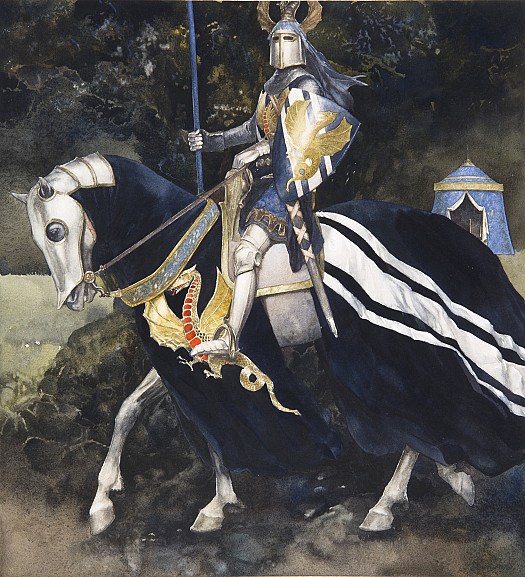Alan Lee was born in Harrow, Middlesex, on 20 August 1947, and educated at Manor Secondary Modern School, Ruislip. Between 1966 and 1969, he studied Graphic Design at Ealing School of Art, where he absorbed the influence of such illustrators as Arthur Rackham and Edmund Dulac, and concentrated on the depiction of Celtic and Norse myths.
A fellow student, the photographer, Derek Ridger, remembers that he was usually the only one hard at work when I got in in the morning and was often still working, in an otherwise empty Art School, in the evening when I left to go home' (a reminiscence on his own blog).
Working as a freelance illustrator from 1970, Alan Lee moved to Chagford, Dartmoor, in 1975, with fellow artists, Brian Froud and Marja Kruÿt. (He married Marja, and together they had two children, Virginia, now an artist, and Owen, a weaver.) He established his reputation in 1978 with Faeries, a volume of fairy lore produced in collaboration with Froud, the book selling 600,000 copies in nine languages by 1984. The success of that project enabled him to devote time to a long-cherished ambition, to illustrate the Medieval collection of Welsh legends, The Mabinogion (1982).
Lee went on to work with several contemporary specialists in fantasy and myth, such as Joan Aiken, Peter Dickinson and Rosemary Sutcliff. He won the 1989 Chesley Award for Best Interior Illustration for Dickinson's Merlin Dreams (1988) and the 1993 Kate Greenaway Medal for Sutcliff’s Black Ships Before Troy (1993), a retelling of Homer's lliad. In the same period, in 1988, he also won the BSFA Award for Best Artwork.
Alongside his work as a book illustrator, Lee began to develop as a conceptual designer for film, beginning with Ridley Scott's Legend (released in 1985), and subsequently including Terry Jones's Erik the Viking (1989).
His fifty illustrations for the centenary edition of The Lord of the Rings, in 1991, were both his crowning achievement to date and the beginning of a new stage in his career, during which he has become particularly associated with the work of J R R Tolkien. His illustrations for the 60th anniversary edition of The Hobbit, in 1997, won him his second Chesley Award for Interior Illustration in 1998, while, in the same year, he won the Annual Award for Best Artist at the World Fantasy Convention. Then, in 2000, he won the grandmaster category of the Spectrum Award for fantastic art.
In 1997, Lee joined another famed Tolkien illustrator, the Canadian, John Howe, as one of two chief conceptual designers on Peter Jackson's project to film The Lord of the Rings. Seven years later, in 2004, he was one of the three winners (with Grant Major and Dan Hennah) of the Academy Award for Best Art Direction for The Return of the King, the third film in the trilogy. In 2005, he released a collection of his conceptual artwork for the films, entitled The Lord of the Rings Sketchbook. Peter Jackson said that, 'Alan Lee's artwork has a beauty and lyricism about it.
His art captured what I hoped to capture with the films' (quoted in Gary Russell, The Art of The Lord of the Rings, New York: Houghton Mifflin Company, 2004, page 63).
In 2008, Lee and Howe were recruited by the director, Guillermo del Toro, in order to ensure a continuity of design between the existing films of The Lord of the Rings and his project to film The Hobbit. When Peter Jackson took over the direction of the three films of The Hobbit, Lee and Howe worked again with him. Though film may seem to have dominated much of his later career, Lee continues to illustrate books. Recent achievements have included The Children of Húrin (2007) and The Tale of Beren and Lúthien (2017), both with texts by J R R Tolkien.
Alan Lee continues to live in rural Devon, and the spirit of his natural surroundings remain an inspiration.


